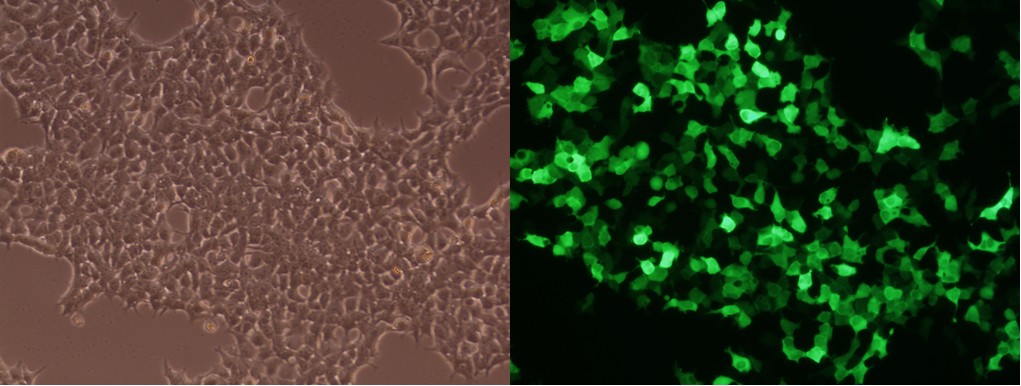Description
Cells to transfect:
Designations: ARPE-19
Cell Synonyms: ARPE19, CRL-2302® Human Retinal Pigmented Epithelium Cell
Organism: Homo sapiens (human)
Tissue: eye; retinal pigmented epithelium; retina
Age: 19 years
Gender: male
Morphology: epithelial
Growth properties: adherent
Karyotype: diploid
Antigen Exp: RPE-specific markers CRALBP and RPE-65
Depositors: L.M. Hjelmeland
ARPE-19 is a spontaneously arising retinal pigment epithelia (RPE) cell line derived in 1986 by Amy Aotaki-Keen from the normal eyes of a 19-year-old male who died from head trauma in a motor vehicle accident. These cells form stable monolayers, which exhibit morphological and functional polarity. ARPE-19 expresses the RPE-specific markers CRALBP and RPE-65.
The Transfection Reagent Features:
- Broad spectrum for the transfection of large plasmid, mRNA, siRNA, and/or other type of nucleic acids, which is best for co-transfection of different type and/or size of nucleic acids.
- Specifically optimized to deliver nucleic acids into ARPE-19 Cells
- Highest efficiency to ensure experimental success
- Lowest Cellular Toxicity-maintain cell density and reduce experimental biases
- 0.5 ml is able to transfect about 1000 wells of 24-well plate
- Deliver single or multiple plasmids
- Compatible with serum
- Suitable for Reverse Transfection
- Compatible with transfection in any plate formats
- Economical: High efficiency means less amount of nucleic acid & reagent is needed
- Developed and manufactured by EZ Biosystems
Data
 FIG. 1. High throughput test of transfection efficiency (determined as RLU/mg) on ARPE-19 cells after transfection of luciferase reporter gene by using our 172 proprietary transfection formulas and several most popular commercial transfection reagents. The yellow box showed the results of 4 commercial transfection reagents. The red lines marked our candidate formulas with the highest transfection efficiency for ARPE-19 cells. This test result was confirmed with repeat experiments. The one that showed the optimal balance of potent & low cytotoxicity among those candidate formulas after flow cytometry analysis on the percentage of 7AAD positive cells was later named as this ARPE-19 Cell Avalanche Transfection Reagent.
FIG. 1. High throughput test of transfection efficiency (determined as RLU/mg) on ARPE-19 cells after transfection of luciferase reporter gene by using our 172 proprietary transfection formulas and several most popular commercial transfection reagents. The yellow box showed the results of 4 commercial transfection reagents. The red lines marked our candidate formulas with the highest transfection efficiency for ARPE-19 cells. This test result was confirmed with repeat experiments. The one that showed the optimal balance of potent & low cytotoxicity among those candidate formulas after flow cytometry analysis on the percentage of 7AAD positive cells was later named as this ARPE-19 Cell Avalanche Transfection Reagent.
 FIG. 2. ARPE-19 cells were transfected with GFP vector (pEGFP-N3) by using ARPE-19 Cell Avalanche® Transfection Reagent. The cells were visualized by Nikon Eclipse Fluorescence microscope 24 hours post transfection.
FIG. 2. ARPE-19 cells were transfected with GFP vector (pEGFP-N3) by using ARPE-19 Cell Avalanche® Transfection Reagent. The cells were visualized by Nikon Eclipse Fluorescence microscope 24 hours post transfection.
For Other Cells
ARPE-19 Cell Avalanche® Transfection Reagent (Human Retinal Pigmented Epithelium Cell) can also be used on the following cells with high transfection efficiencies.
hTERT RPE-1 Cell
786-O Cell
Caki-1 Cell
MDCK Cell
Vero Cell
DU 145 Cell
PC-3 Cell
AR42J Cell
Recommended protocols for these cells will be provided with the reagent. The protocols usually provide satisfactory transfection efficiency with invisible cytotoxicity. However, optimization may be needed for certain type of cells. Optimizations may include: the amount of DNA and this transfection reagent; cell density; transfection reagent/DNA ratio, or incubation time for the mixture of transfection reagent/DNA etc. For best transfection result, we recommend using the respective cell type/cell line specific Avalanche transfection reagents. Those reagents have been optimized on both recipes and protocols, and have been proved to have the best transfection results for the respective cell lines or primary cells. You can easily find the respective Avalanche transfection reagents specific for your cells by using the filters of our product list.
Additional Information
| Weight | 0.5 lbs |
|---|---|
| Adherence Phenotype |
Adherent |
| Cell Type |
Epithelial Cell |
| Disease |
Healthy |
| Names starting from |
A |
| Primary/Cell Line |
Cell Line |
| Product Sizes |
0.5 ml, 1.5 ml |
| Species |
Human |
| Tissue Sources |
Retina |
| Subcategories |
Cell Type/Cell Line Specific |
Documents
Protocols
MSDS
Citations or Feedback


